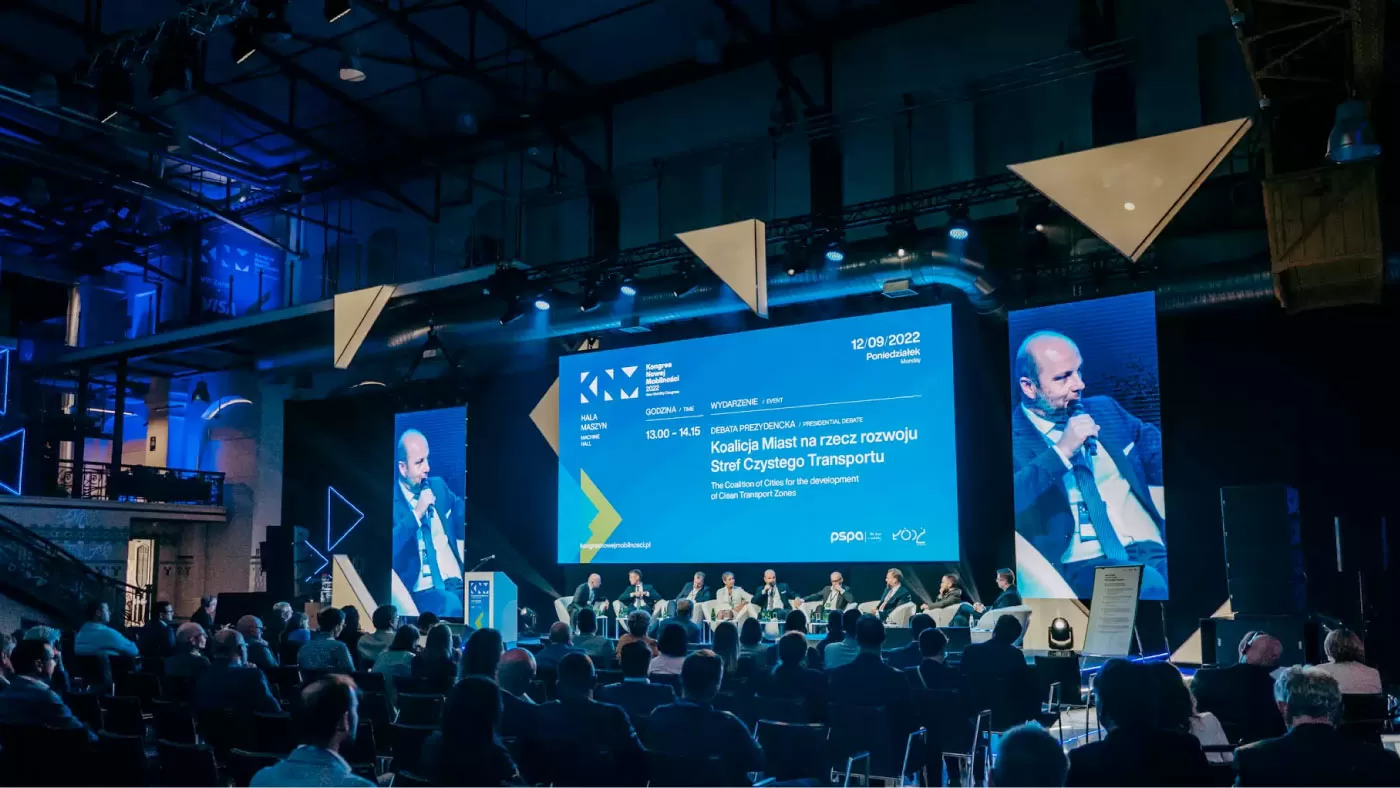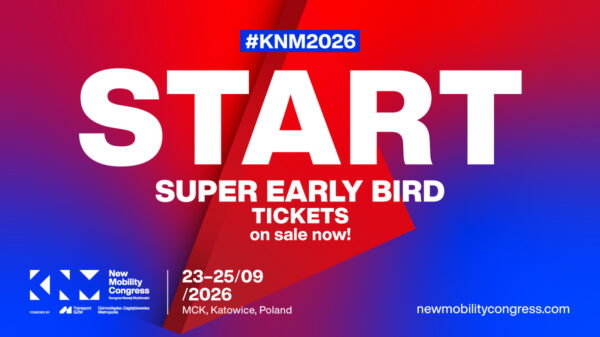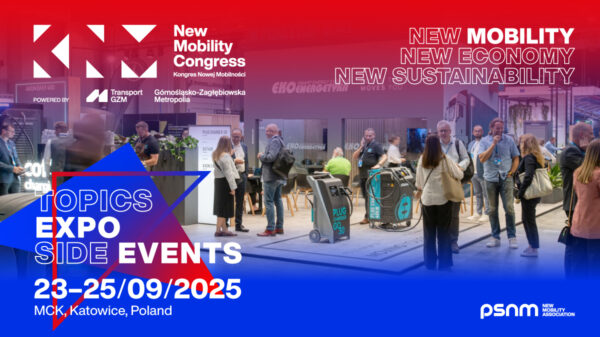Last year, Łódź reigned as the Polish hub of e-mobility for 72 hours once again. The third edition of KNM 2022, the largest conference in the zero-emission transport sector in the CEE region, achieved record-breaking attendance. Here are the key takeaways from the Congress.
From September 12th to 14th, the impressive Łódź EC1 venue, spanning over 3,500 square meters, played host to KNM 2022. The conference was organized by the Polish Alternative Fuels Association (PSPA) and the City of Łódź, and brought together a record number of 1,500 participants from across Europe, including representatives from central administration, local governments, experts and practitioners of the e-mobility market, and dozens of exhibitors. The conference featured more than 80 insightful debates, roundtable sessions and workshops with almost 250 panellists, as well as accompanying events – premieres, exhibitions and demonstrations.
1. Innovation should be Poland’s priority
The automotive sector is currently undergoing a significant transformation and has been facing considerable disruption in recent years. These disruptions include global supply chain challenges, dwindling car supplies in both primary and secondary markets, rising prices of vehicles, raw materials, and components, inflation, the conflict in Ukraine, and the COVID-19 pandemic. It is evident from numerous examples across the globe that investing in innovative solutions that promote economic modernization during times of heightened geopolitical and economic challenges is crucial. In this regard, Poland can learn from the best. One of the goals of the New Mobility Congress 2022 was to exchange best practices and strengthen the cooperation of the Polish e-mobility industry on an international scale.
– We know that Poland is a significant player in the e-mobility market. That’s why it’s essential to support this industry. Let’s not overlook Poland’s leading role in producing electric buses and lithium-ion batteries. The Dutch contribution can further enhance the potential of the Polish e-mobility industry. However, developing this sector requires closer collaboration among key stakeholders, and I’m delighted that PSPA is dedicating significant attention to this issue during the New Mobility Congress, – said Daphne Bergsma, Ambassador of the Kingdom of the Netherlands.
2. The domestic market is crucial to strengthening Poland’s position in the e-bus segment.
Zero-emission public transport is one of Poland’s specializations in the European e-mobility sector supply chain. This was underscored at the New Mobility Congress 2022, where the highly anticipated premiere of the MAN Lion’s City 18 battery-electric bus, produced in Starachowice, took place. The conference also featured the presentation of the report “Case study: Poland – The European export center for electric buses,” which PSPA developed in partnership with the World Bank Group. One of the main drivers of the impressive market position of Polish electric bus manufacturers is the growing demand from local government units. By mid-2023, the Polish fleet of e-buses is set to expand to 950 vehicles, marking a YOY growth rate of 32.5%.
– A total of 1,937 electric buses were exported from our factories to other EU markets between 2017 and 2021. This represents almost one-third of all e-buses exported from the EU. The total value of Polish exports from this sector during the aforementioned period exceeded EUR 750 million accounting for almost 40% of the total value of exports from the Member States. The high demand on the domestic market stimulates the export capacity of Polish companies. However, competition is increasing, and maintaining Poland’s leading position necessitates, the continuation of the subsidy program for local governments, as emphasized by Maciej Mazur, PSPA Chief Executive Officer.
3. The expansion of public charging infrastructure in Poland must accelerate
Poland’s EV fleet has been growing at a much faster rate than its network of public charging stations in recent years. This has resulted in an increased ratio of electric vehicles to charging points, which has risen from 5.6 in 2019 to 10.7 in 2021. If this trend persists, in the context of the introduction of a ban on the sale of ICE vehicles in the European Union, it could pose the risk of a shortage of chargers and a significant deterioration in the Polish automotive market. Without an adequate number of charging stations, electrification of the Polish vehicle fleet on a mass scale will be hindered. Unfortunately, the development of infrastructure is delayed by a number of systemic barriers. Recognizing these challenges, PSPA, together with its partners, including leading charging infrastructure operators, has put forward proposals for changes to the current legislation, which were presented at the New Mobility Congress 2022.
The proposed special act is guided by four main objectives. The first objective is to significantly reduce the lead time for the construction of connections of public charging stations to the DSO network. The second goal is to introduce mechanisms that will facilitate and stimulate DSOs to invest in the expansion of their distribution networks. The third category of proposals aims to establish precisely defined standards for the construction of connections by DSOs (e.g. with regard to the location of the connection point or the possibility of choosing the voltage level, regardless of the capacity of a charging station). Finally, our proposals should lead to sorting out the ownership structure of the energy infrastructure located at the Rest and Service Areas – said Rafał Czyżewski, President of the Management Board of GreenWay Polska.
4. Poland is a European leader in the battery sector
Poland holds the fifth spot globally and takes the lead in Europe in lithium-ion battery production, outranked solely by China, South Korea, the United States, and Japan. The country boasts manufacturing of both li-ion cells and various associated components, including electrolytes, separators, cathodes, copper foil, battery modules, and traction batteries for electric vehicles. During the New Mobility Congress of 2022, delegates from enterprises, public administration, and universities convened to discuss strategies for preserving Poland’s distinguished standing in the worldwide supply chain for lithium-ion batteries.
– The location of Poland and other CEE markets in the center of Europe is certainly a strong advantage from the perspective of LG Energy Solution Wrocław. The other one is an exceptional potential of people – educated and specialised experts. Thanks to this, the sales of LG Energy Solution’s EV batteries are continuously growing, and production is ongoing. It is worth noting that Poland has the opportunity to strengthen its position as a key player in the rapidly developing e-mobility industry – not only in terms of sales, but mainly in the area of component manufacturing – said Yong Girl Lee, Business Support Director, LG Energy Solution Wrocław.
5. Cooperation among local governments will accelerate the implementation of Clean Transport Zones.
One of the topics on the agenda of the New Mobility Congress 2022 was the Mayors Debate “Coalition of Cities for the Development of Clean Transport Zones”, that boasted the presence of a dozen mayors and deputy mayors from several Polish cities, such as Bydgoszcz, Łódź, Opole, Rzeszów, Słupsk, Sosnowiec, and Warsaw, alongside the Union of Polish Metropolises and the Metropolis GZM. The discourse primarily revolved around sharing best practices and refining the laws that govern the creation of clean transport zones.
– In 2021, we launched the PSPA Local Government Committee, an excellent project for knowledge sharing among Polish local government units. It is a platform for planning future joint activities. We address all issues related to the development of zero-emission transport in Polish cities there. Within a year since the Committee was launched, we have held seven meetings attended by 168 participants. One of the outcomes of our activities was the Coalition of Cities for the Development of Clean Transport Zones. Importantly, the demands addressed to the government were mostly taken into account. The Committee’s further work will focus on the priority challenges for local governments in terms of modernizing transport and transforming it towards zero-emission, including tools that facilitate the expansion of urban charging infrastructure and engaging in a dialogue with residents to effectively establish clean transport zones – said Adam Wieczorek, Deputy Mayor of the City of Łódź.
6. The electrification of a company fleet requires comprehensive planning
Companies are the backbone of the Polish e-mobility market. According to the PSPA report
“Polish EV Outlook”, in 2021 companies were responsible for 3/4 of EV registrations in the Polish market, even when excluding sole traders. Several debates, panels, and discussion workshops during the New Mobility Congress 2022 focused on the issue of optimal implementation of electrified fleets in companies.
– Companies should treat fleet transformation as a project, with clearly defined assumptions and a predetermined timeline for verification. It is worth dividing the replacement of vehicles into phases – pilot, first phase and second phase. A fleet utilisation analysis should be carried out, e.g. by means of online surveys targeting potential EV users. It is also important to conduct an audit of the electricity network to determine the connectivity of charging stations. Driver training is also crucial as operating electric vehicles is different from driving ICE vehicles. Electrifying a fleet can bring numerous benefits – both financial, related to the lower total cost of ownership (TCO), as well as image – said Daniel Trzaskowski, PhD, Director of the Fleet Sales Department at Volkswagen Financial Services.
5. Poland needs to prepare for AFIR
A key proposal of the “Fit for 55” package presented by the European Commission in 2021 is to repeal the 2014/94/EU Directive of the European Parliament and of the Council of 22 October 2014 on the development of alternative fuel infrastructure and replace it with a new regulation. The AFIR project aims to link the development of EV fleets to the expansion of public charging infrastructure capacity. From the perspective of Poland and other EU Member States, this means the need to multiply investments in the development of public charging networks.
– Poland’s current EV fleet remains relatively small, enabling it to satisfy the projected demands outlined in the upcoming regulation. As of March 2022, the public charging infrastructure network’s installed capacity stood at 77 MW, which exceeded the AFIR draft’s estimates by 39 MW. Nevertheless, considering the PSPA “Polish EV Outlook 2022” report’s forecasts for the BEV and PHEV fleet’s development in Poland, as well as the regulation’s stipulated requirements, the capacity of charging stations operational in Poland must expand to 435.8 MW by 2025, 1383.5 MW by 2030, and 2613.1 MW by 2035. This represents a 34-fold increase in public infrastructure installed capacity by 2035. Thus, it will be a huge challenge to meet the requirements set by the AFIR for the next few years – said Aleksander Rajch, PSPA External Relations Director.
8. The “My EV” program is not perfect, but it is boosting the development of the EV market in Poland
Over a year has passed since the launch of the “My EV” program by the National Fund for Environmental Protection and Water Management. During the New Mobility Congress 2022, a panel discussion took place featuring representatives from OEMs, CFMs, and the National Fund to evaluate the impact of the incentives offered under the program. The participants acknowledged that the incentives, which provide up to PLN 27,000 for cars and up to PLN 70,000 for vans, have successfully encouraged the purchase of electric vehicles. However, certain aspects of the support system, including complex procedures, lengthy waiting periods for fund disbursement, and price restrictions on supported vehicles, require modification to enhance the program’s effectiveness.
– The implementation of the “My EV” program was supported with PLN 700 million. Taking into account all the circumstances and the current market situation, we see the year of operation of the support system as a success. I acknowledge the arguments about the necessary adjustment for inflation, but I will not be making any declarations that due to inflation and rising vehicle prices the amounts provided for in the program regulations will increase – said Paweł Mirowski, Deputy President of the Management Board of the National Fund for Environmental Protection and Water Management
9. With eHDVs now available, it’s time to develop the charging infrastructure and introduce a support scheme
The decarbonization of heavy-duty vehicles is a crucial step towards achieving Europe’s climate-neutrality objective, given that these vehicles make up less than 3% of the continent’s fleet but account for a significant 19.2% of CO2 emissions from road transport. This is especially pertinent in Poland, which boasts the EU’s largest fleet of vehicles over 3.5 t GVW. Electric trucks are already available on the market, as evidenced by the start of deliveries to IKEA factories with zero-emission Volvo trucks belonging to Raben’s fleet, which was announced during the KNM 2022. However, the main challenges to the development of the eHDV market in Poland remain the underdeveloped charging infrastructure and the lack of effective subsidies that are dynamising the electrified road heavy transport market in selected Western European countries.
– Our company already offers a full range of battery-electric trucks. We are therefore ready for the change. The optimal planning of routes and charging infrastructure is a critical factor in the successful implementation of zero-emission trucks into the fleet. High-powered chargers are essential for the development of this sector, though. Poland lacks the support in this area that is available in Scandinavia or Germany – said Małgorzata Kulis, President of the Management Board of Volvo Polska.
10. Comprehensive e-mobility education is crucial
At the KNM 2022, there was significant emphasis on enhancing the qualifications of human resources in Poland and aligning the competencies of secondary and higher education graduates with employer requirements. In order to achieve this, there is a need to strengthen collaboration between academia and businesses. The vocational and engineering curricula in Poland must prioritize integrated and process thinking. In this regard, dual education, which allows students to gain theoretical and practical knowledge by attending classes at universities and potential workplaces, can be a useful approach.
– E-mobility is a very complex, multifaceted trend, so higher education is best suited to specialise in this field. However, streamlined education should begin at the secondary school level – said Jacek Dybała, PhD, Eng., Vice-Dean for the Development and Research of the Faculty of Automotive and Construction Machinery Engineering at the Warsaw University of Technology
11. The growth of the li-ion battery recycling industry is hindered by administrative barriers
As e-mobility continues to develop and the supply of essential raw materials such as nickel and cobalt becomes limited and more expensive, recycling lithium-ion batteries is becoming increasingly important. According to forecasts, revenues for companies operating in this industry will increase by 2030 to almost USD 40 billion. Poland – a European leader in the battery sector – seems to be an ideal location for recovery facilities. Participants of the New Mobility Congress 2022 identified Poland’s potential in this area and a number of administrative barriers limiting this opportunity at this stage.
– All lithium-ion batteries that are no longer viable for electric vehicles still have untapped energy potential. Poland has the potential to become a recycling leader in the battery industry, but this will require collaboration with manufacturers. Unfortunately, the recycling industry is struggling to keep pace with the speed of e-mobility development.
The theoretical construction of a plant capable of recovering the necessary raw materials typically takes four to five years. The public administration should implement regulations to limit unjustified protests that could impede progress – said Robert Makieła, Managing Director of Rare Metals.
12. It is necessary to standardise EV charging services
Based on IEA projections, the number of public charging points across Europe is expected to surge from 334,000 in 2021 to over 1.5 million in 2025, along with the increase in the number of infrastructure operators, which currently exceeds 300. However, from the perspective of EV drivers, the current system of requiring multiple RFID cards and mobile apps to access different charging networks makes it challenging to travel freely across Europe. The KNM 2022 conference showcased potential solutions aimed at unifying the payment system for EV charging services.
– Visa’s objective is to simplify payment processes for everyone, which includes EV charging services. We understand the need to tailor our offerings to the evolving landscape and customer demands. For this reason, we are working on innovative solutions such as paying for charging services via cards, contactless payments, mobile apps, loyalty programs, and “destination parking” to attract customers to choose charging stations that offer a unified payment system – said Stephen King, VP Sustainability Solutions, Visa.
Contact
PRESS OFFICE
New Mobility Congress 2023
Maciej Gis
Press Officer



